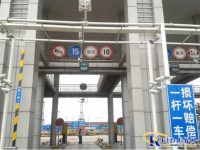
Electronic gate project in Nanjiang port area of Tianjin port using RFID technology
[ad_1]
1. Introduction to the system
The rapidly growing port and terminal business volume has higher and higher requirements for the port and terminal management system. The RFID radio frequency identification technology, container number automatic identification technology, electronic weighbridge technology, computer technology, automatic control and other technologies are closely combined to build a construction based on RFID technology. The electronic gate system and logistics management system of the port terminal can greatly improve the management efficiency and service level of the port terminal.RFIDWith the help of radio frequency identification technology, the automation of freight vehicles entering and leaving the terminal will become a reality. The application of RFID radio frequency identification makes the port terminal play a greater potential.

2. Project Overview
This project aims to promote the platformization and serviceization of vehicle-related information in public security, port traffic and other systems, with electronic license plates as the information carrier, and RFID as the basic information collection method to realize the sharing of vehicle-related information resources and improve vehicle management. Information level. The whole system is based on the system architecture of the Internet of Things and consists of the perception layer of the Internet of Things, the network layer of the Internet of Things and the application layer of the Internet of Things. UHF RFID products are used to collect information on electronic tags through RFID readers. The data is processed and integrated to build a comprehensive Tianjin Port vehicle management information data platform to achieve full automation and electronic vehicle management.
3. System composition
The system consists of RFID electronic license plate automatic identification system, container number automatic identification system, infrared radiation technology, electronic weighbridge system, lane human-computer interaction system, centralized monitoring system, LED display screen, customs interface and other parts to meet customs requirements and port terminals. Actual job requirements.
Fourth, the system implementation benefits
◇ 1. Improve the efficiency of passing vehicles at the entry and exit passages of ports and terminals, and reduce the time for vehicle order processing from the previous 4 minutes to less than 30 seconds now (including manual box inspection).
◇ 2. Reduce the vehicle congestion at the entrance of the port terminal. In the past, the queue of vehicles on the road at the entrance of the terminal exceeded 300 meters. After the completion of the intelligent gate, the arrival at the port will be realized.
◇ 3. Save labor costs for the port and wharf. In the past, each channel required a staff to handle the documents. After the completion of the intelligent electronic gate, there is no need for staff to be on duty.
◇ 4. The waiting time for vehicles entering and leaving the port is reduced, which saves costs for drivers and transportation companies, thereby reducing logistics costs.
The implementation of this project will effectively solve the automatic identification of vehicles, realize precise management of vehicles, automation of vehicles leaving the port, traffic statistics and analysis, application services for vehicles in the port, and public security management of vehicles in the port, which will directly bring economic and political benefits to Tianjin Port.
[ad_2]



